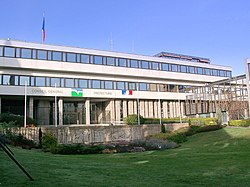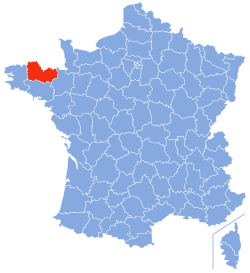Department in Brittany, France
| Côtes-d'Armor Aodoù-an-Arvor (Breton) | |
|---|---|
| Department | |
 The departmental council and prefectural building in Saint-Brieuc. The departmental council and prefectural building in Saint-Brieuc. | |
 Flag Flag Coat of arms Coat of arms | |
 Location of Côtes-d'Armor in France Location of Côtes-d'Armor in France | |
| Coordinates: 48°20′N 02°50′W / 48.333°N 2.833°W / 48.333; -2.833 | |
| Country | France |
| Region | Brittany |
| Prefecture | Saint-Brieuc |
| Subprefectures | Dinan Guingamp Lannion |
| Government | |
| • President of the departmental council | Christian Coail (PS) |
| Area | |
| • Total | 6,878 km (2,656 sq mi) |
| Population | |
| • Total | 609,598 |
| • Rank | 42nd |
| • Density | 89/km (230/sq mi) |
| Time zone | UTC+1 (CET) |
| • Summer (DST) | UTC+2 (CEST) |
| Department number | 22 |
| Arrondissements | 4 |
| Cantons | 27 |
| Communes | 348 |
| ^1 French Land Register data, which exclude estuaries, and lakes, ponds, and glaciers larger than 1 km | |
The Côtes-d'Armor (/koʊt dɑːrmər/ koht dar-mər, /-dɑːrmɔːr/ -dar-mor; French pronunciation: [kot daʁmɔʁ] ; Breton: Aodoù-an-Arvor, [ˈoːdu ãn ˈarvor]), formerly known as Côtes-du-Nord until 1990 (Breton: Aodoù-an-Hanternoz, [ˈoːdu ãn ˌhãntɛrˈnoːs]), is a department in the north of Brittany, in northwestern France. In 2019, it had a population of 600,582.
History
Côtes-du-Nord was one of the original 83 departments created on 4 March 1790 following the French Revolution. It was made up from the near entirety of the ancient Pays de Saint-Brieuc, most of historical Trégor, the eastern half of Cornouaille, and the north-western part of the former diocese of Saint-Malo.
On 27 February 1990, the name was changed to Côtes-d'Armor: the French word côtes means "coasts" and ar mor is "the sea" in Breton. The name also recalls that of the Roman province of Armorica ("the coastal region").
Geography
Côtes-d'Armor is part of the current administrative region of Brittany and is bounded by the departments of Ille-et-Vilaine to the east, Morbihan to the south, and Finistère to the west, and by the English Channel to the north.
The region is an undulating plateau including three well-marked ranges of hills in the south. A granitoid chain, the Monts du Méné, starting in the south-east of the department runs in a north-westerly direction, forming the watershed between the rivers running respectively to the English Channel and the Atlantic Ocean. Towards its western extremity this chain bifurcates to form the Montagnes Noires in the south-west and the Monts d'Arrée in the west of the department. Off the coast, which is steep, rocky and much indented, are the Jentilez, Bréhat and other small islands. The principal bays are those of Saint-Malo and Saint-Brieuc.
Principal towns
The most populous commune is Saint-Brieuc, the prefecture. As of 2019, there are 6 communes with more than 10,000 inhabitants:
| Commune | Population (2019) |
|---|---|
| Saint-Brieuc | 43,605 |
| Lannion | 20,210 |
| Lamballe-Armor | 16,688 |
| Dinan | 14,407 |
| Plérin | 14,309 |
| Ploufragan | 11,383 |
Demographics
The inhabitants of the department are known in French as Costarmoricains.
|
| |||||||||||||||||||||||||||||||||||||||||||||||||||||||||||||||||||||||||||
| ||||||||||||||||||||||||||||||||||||||||||||||||||||||||||||||||||||||||||||
| Sources: | ||||||||||||||||||||||||||||||||||||||||||||||||||||||||||||||||||||||||||||
Politics
See also: Departmental Council of Côtes-d'ArmorCôtes-d'Armor's long tradition of anti-clericalism, especially in the interior around Guingamp (a former Communist stronghold), has often led to the department's being seen as an area of left-wing exceptionalism in a region that historically was otherwise strongly Catholic and right-wing. The current president of the departmental council, Christian Coail, is a member of the Socialist Party.
| Party groupings | seats | |
|---|---|---|
| Centre et droite républicaine | 32 | |
| Socialiste et républicain | 15 | |
| Communiste et républicain | 5 | |
| non-party | 2 | |
Current National Assembly Representatives
Culture
The western part of the department is part of the traditionally Breton-speaking "Lower Brittany" (Breizh-Izel in Breton). The boundary runs from Plouha to Mûr-de-Bretagne. The Breton language has become an intense issue in many parts of Brittany, and many Breton-speakers advocate for bilingual schools. Gallo is also spoken in the east and is offered as a language in the schools and on the baccalaureat exams.
Gallery
-
 Paimpol
Paimpol
-
Perros-Guirec
-
Fort-la-Latte
-
 Cap Fréhel
Cap Fréhel
-
Castel Meur house in Plougrescant
-
 Statue of Bertrand du Guesclin in Dinan
Statue of Bertrand du Guesclin in Dinan
Notable people
- Anne Beaumanoir (1923–2022), one of the Righteous Among the Nations, was born in Guildo.
- Bernadette Cattanéo (1899–1963), trade unionist and militant communist
- English-born poet Robert William Service (1874–1958), known as the "Bard of the Yukon", is buried in Lancieux.
See also
- Cantons of the Côtes-d'Armor department
- Communes of the Côtes-d'Armor department
- Arrondissements of the Côtes-d'Armor department
References
- "Répertoire national des élus: les conseillers départementaux". data.gouv.fr, Plateforme ouverte des données publiques françaises (in French). 4 May 2022.
- "Populations de référence 2022" (in French). The National Institute of Statistics and Economic Studies. 19 December 2024.
- ^ Populations légales 2019: 22 Côtes-d'Armor, INSEE
-
 One or more of the preceding sentences incorporates text from a publication now in the public domain: Chisholm, Hugh, ed. (1911). "Côtes-du-Nord". Encyclopædia Britannica. Vol. 7 (11th ed.). Cambridge University Press. p. 249.
One or more of the preceding sentences incorporates text from a publication now in the public domain: Chisholm, Hugh, ed. (1911). "Côtes-du-Nord". Encyclopædia Britannica. Vol. 7 (11th ed.). Cambridge University Press. p. 249.
- "Historique des Côtes-d'Armor". Le SPLAF.
- "Évolution et structure de la population en 2016". INSEE.
- "Assemblée nationale ~ Les députés, le vote de la loi, le Parlement français". assemblee-nationale.fr.
External links
- (in French) Prefecture website
- (in French) Departmental Council website
- (in French) Tourist board website